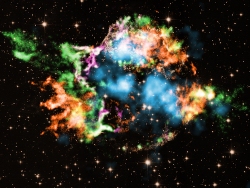Stars are
chemical factories, and the way in which they
build up complex elements from simpler component is well understood. How stars distribute these products is less well understood. Massive
stellar winds from high-mass stars, moving at velocities of millions of miles per hour, carrying about an earth's mass of material from the star every year, play an important role. The most important means of delivering chemicals from the star to its galactic neighborhood (or beyond) is through supernovae, the explosion that follows the exhaustion of thermonuclear fuel at the core of a high-mass star. During a supernova, the stellar core, the furnace powering the star and holding it up against gravity, stops producing energy, causing the core and inner part of the star to implode. Somehow this theoretical implosion is converted to an actual explosion and the star blows itself apart. How this change of infall to outflow happens is a matter of uncertainty and debate. Earlier theoretical models completely failed to produce a stellar explosion through relatively straightforward physics. More modern models suggest that subatomic particles called neutrinos play a key role in the explosion.
Neutrinos, so-called "ghost particles" are difficult to detect since they hardly ever interact with matter under normal conditions. In fact, about
100 trillion neutrinos pass through your body every second without you being aware of them, or you suffering any ill effects because of them. But under the extremely high densities and temperatures near the center of a collapsing star, neutrinos can exert substantial pressure, forming "bubbles" in the interior of the star which can play an important role in driving the supernova explosion. The image above is a beautiful X-ray image from the
Chandra and
NuSTAR X-ray observatories of the Cas A supernova remnant (superimposed on an optical image from the
Hubble Space Telescope). The different colors code for different elements in the supernova ejecta - iron (orange), oxygen (purple), the amount of silicon compared to magnesium (green), titanium (from NuSTAR, in light blue) - and shows that different elements are found in different portions of the hot ejected gas. A detailed study of the distribution of elements seen in the Chandra and NuSTAR observations, especially titanium and chromium, suggest that these elements were formed at temperatures and densities very similar to those predicted by neutrino bubble explosion models.
 HEAPOW: Fountains of Titanium (2021 May 03)
HEAPOW: Fountains of Titanium (2021 May 03)